Analysis of Cardino Ltd's Impairment Testing and Economic Reality
VerifiedAdded on 2020/05/16
|9
|2862
|47
Report
AI Summary
This report provides a comprehensive analysis of Cardino Limited's financial reporting practices, focusing on impairment testing and the concept of economic reality. The report examines the company's approach to impairment testing of various assets, including goodwill, property, plant, and equipment, and trade debtors, in accordance with Australian Accounting Standard 136. It details the methodologies used, such as the value in use method and the allocation of goodwill to cash-generating units. The report further explores the company's accounting estimates and judgments, particularly concerning future cash flows and discount rates. Furthermore, it delves into the subjectivity involved in the impairment testing process and provides insights into the insights gained from the impairment process, such as the use of weighted average cost of capital as a discounting rate. The second part of the report discusses the economic reality in financial reporting, particularly in the context of lease accounting. It examines the shift in accounting standards regarding leases and its impact on the recognition of liabilities and assets, specifically highlighting the changes in lease accounting and the implications for companies' financial positions. The report concludes by emphasizing the importance of accurate financial reporting and the role of economic reality in providing stakeholders with a clear understanding of a company's financial health.
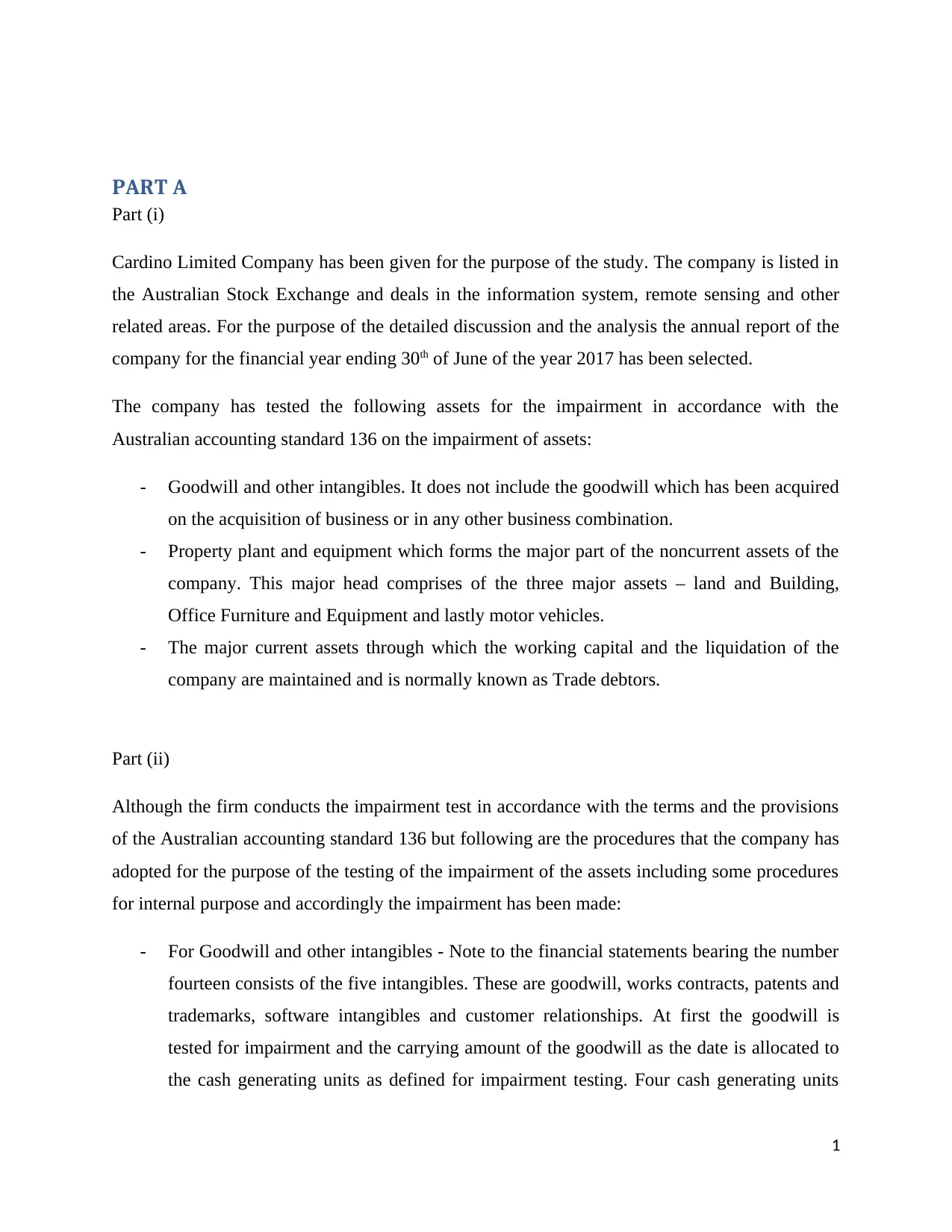
PART A
Part (i)
Cardino Limited Company has been given for the purpose of the study. The company is listed in
the Australian Stock Exchange and deals in the information system, remote sensing and other
related areas. For the purpose of the detailed discussion and the analysis the annual report of the
company for the financial year ending 30th of June of the year 2017 has been selected.
The company has tested the following assets for the impairment in accordance with the
Australian accounting standard 136 on the impairment of assets:
- Goodwill and other intangibles. It does not include the goodwill which has been acquired
on the acquisition of business or in any other business combination.
- Property plant and equipment which forms the major part of the noncurrent assets of the
company. This major head comprises of the three major assets – land and Building,
Office Furniture and Equipment and lastly motor vehicles.
- The major current assets through which the working capital and the liquidation of the
company are maintained and is normally known as Trade debtors.
Part (ii)
Although the firm conducts the impairment test in accordance with the terms and the provisions
of the Australian accounting standard 136 but following are the procedures that the company has
adopted for the purpose of the testing of the impairment of the assets including some procedures
for internal purpose and accordingly the impairment has been made:
- For Goodwill and other intangibles - Note to the financial statements bearing the number
fourteen consists of the five intangibles. These are goodwill, works contracts, patents and
trademarks, software intangibles and customer relationships. At first the goodwill is
tested for impairment and the carrying amount of the goodwill as the date is allocated to
the cash generating units as defined for impairment testing. Four cash generating units
1
Part (i)
Cardino Limited Company has been given for the purpose of the study. The company is listed in
the Australian Stock Exchange and deals in the information system, remote sensing and other
related areas. For the purpose of the detailed discussion and the analysis the annual report of the
company for the financial year ending 30th of June of the year 2017 has been selected.
The company has tested the following assets for the impairment in accordance with the
Australian accounting standard 136 on the impairment of assets:
- Goodwill and other intangibles. It does not include the goodwill which has been acquired
on the acquisition of business or in any other business combination.
- Property plant and equipment which forms the major part of the noncurrent assets of the
company. This major head comprises of the three major assets – land and Building,
Office Furniture and Equipment and lastly motor vehicles.
- The major current assets through which the working capital and the liquidation of the
company are maintained and is normally known as Trade debtors.
Part (ii)
Although the firm conducts the impairment test in accordance with the terms and the provisions
of the Australian accounting standard 136 but following are the procedures that the company has
adopted for the purpose of the testing of the impairment of the assets including some procedures
for internal purpose and accordingly the impairment has been made:
- For Goodwill and other intangibles - Note to the financial statements bearing the number
fourteen consists of the five intangibles. These are goodwill, works contracts, patents and
trademarks, software intangibles and customer relationships. At first the goodwill is
tested for impairment and the carrying amount of the goodwill as the date is allocated to
the cash generating units as defined for impairment testing. Four cash generating units
1
Paraphrase This Document
Need a fresh take? Get an instant paraphrase of this document with our AI Paraphraser
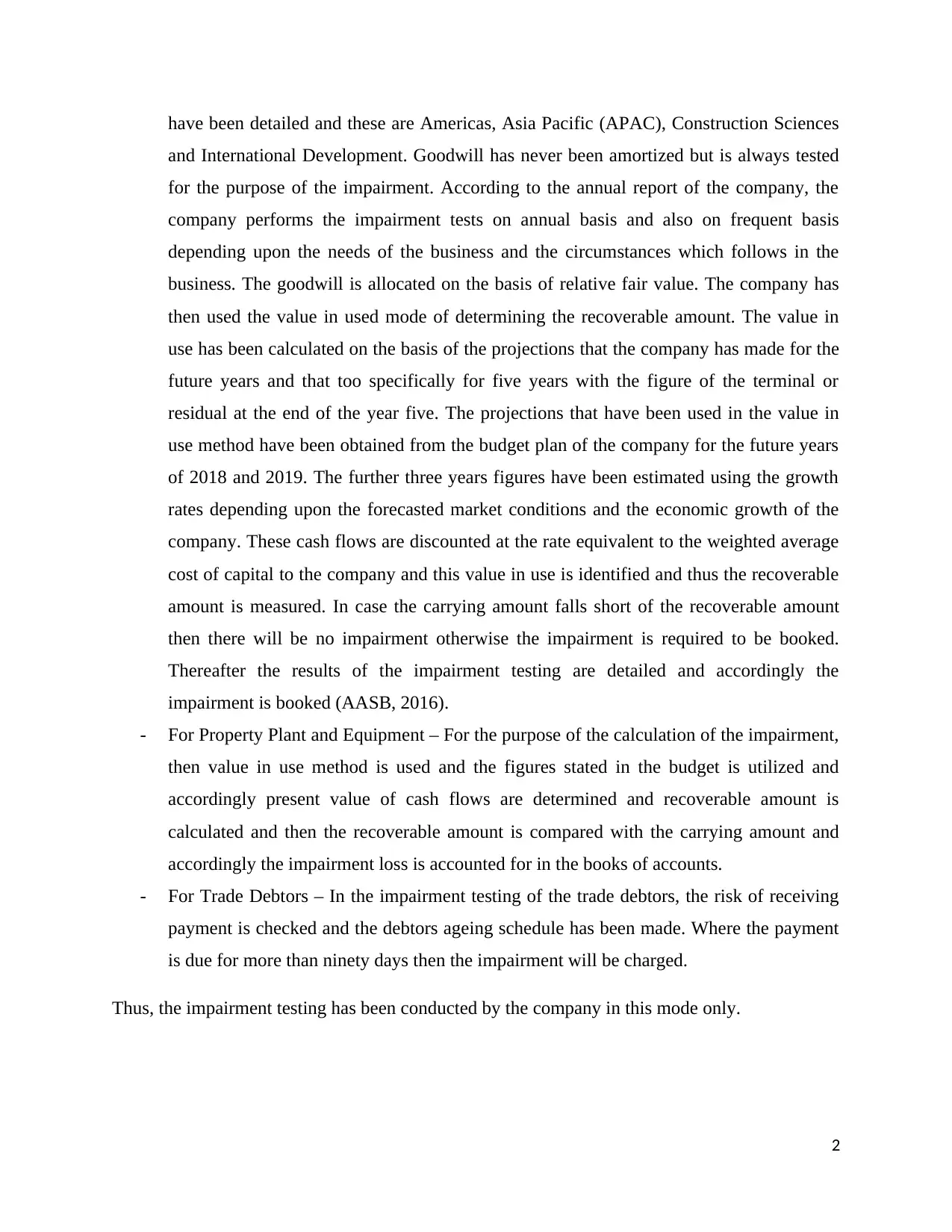
have been detailed and these are Americas, Asia Pacific (APAC), Construction Sciences
and International Development. Goodwill has never been amortized but is always tested
for the purpose of the impairment. According to the annual report of the company, the
company performs the impairment tests on annual basis and also on frequent basis
depending upon the needs of the business and the circumstances which follows in the
business. The goodwill is allocated on the basis of relative fair value. The company has
then used the value in used mode of determining the recoverable amount. The value in
use has been calculated on the basis of the projections that the company has made for the
future years and that too specifically for five years with the figure of the terminal or
residual at the end of the year five. The projections that have been used in the value in
use method have been obtained from the budget plan of the company for the future years
of 2018 and 2019. The further three years figures have been estimated using the growth
rates depending upon the forecasted market conditions and the economic growth of the
company. These cash flows are discounted at the rate equivalent to the weighted average
cost of capital to the company and this value in use is identified and thus the recoverable
amount is measured. In case the carrying amount falls short of the recoverable amount
then there will be no impairment otherwise the impairment is required to be booked.
Thereafter the results of the impairment testing are detailed and accordingly the
impairment is booked (AASB, 2016).
- For Property Plant and Equipment – For the purpose of the calculation of the impairment,
then value in use method is used and the figures stated in the budget is utilized and
accordingly present value of cash flows are determined and recoverable amount is
calculated and then the recoverable amount is compared with the carrying amount and
accordingly the impairment loss is accounted for in the books of accounts.
- For Trade Debtors – In the impairment testing of the trade debtors, the risk of receiving
payment is checked and the debtors ageing schedule has been made. Where the payment
is due for more than ninety days then the impairment will be charged.
Thus, the impairment testing has been conducted by the company in this mode only.
2
and International Development. Goodwill has never been amortized but is always tested
for the purpose of the impairment. According to the annual report of the company, the
company performs the impairment tests on annual basis and also on frequent basis
depending upon the needs of the business and the circumstances which follows in the
business. The goodwill is allocated on the basis of relative fair value. The company has
then used the value in used mode of determining the recoverable amount. The value in
use has been calculated on the basis of the projections that the company has made for the
future years and that too specifically for five years with the figure of the terminal or
residual at the end of the year five. The projections that have been used in the value in
use method have been obtained from the budget plan of the company for the future years
of 2018 and 2019. The further three years figures have been estimated using the growth
rates depending upon the forecasted market conditions and the economic growth of the
company. These cash flows are discounted at the rate equivalent to the weighted average
cost of capital to the company and this value in use is identified and thus the recoverable
amount is measured. In case the carrying amount falls short of the recoverable amount
then there will be no impairment otherwise the impairment is required to be booked.
Thereafter the results of the impairment testing are detailed and accordingly the
impairment is booked (AASB, 2016).
- For Property Plant and Equipment – For the purpose of the calculation of the impairment,
then value in use method is used and the figures stated in the budget is utilized and
accordingly present value of cash flows are determined and recoverable amount is
calculated and then the recoverable amount is compared with the carrying amount and
accordingly the impairment loss is accounted for in the books of accounts.
- For Trade Debtors – In the impairment testing of the trade debtors, the risk of receiving
payment is checked and the debtors ageing schedule has been made. Where the payment
is due for more than ninety days then the impairment will be charged.
Thus, the impairment testing has been conducted by the company in this mode only.
2
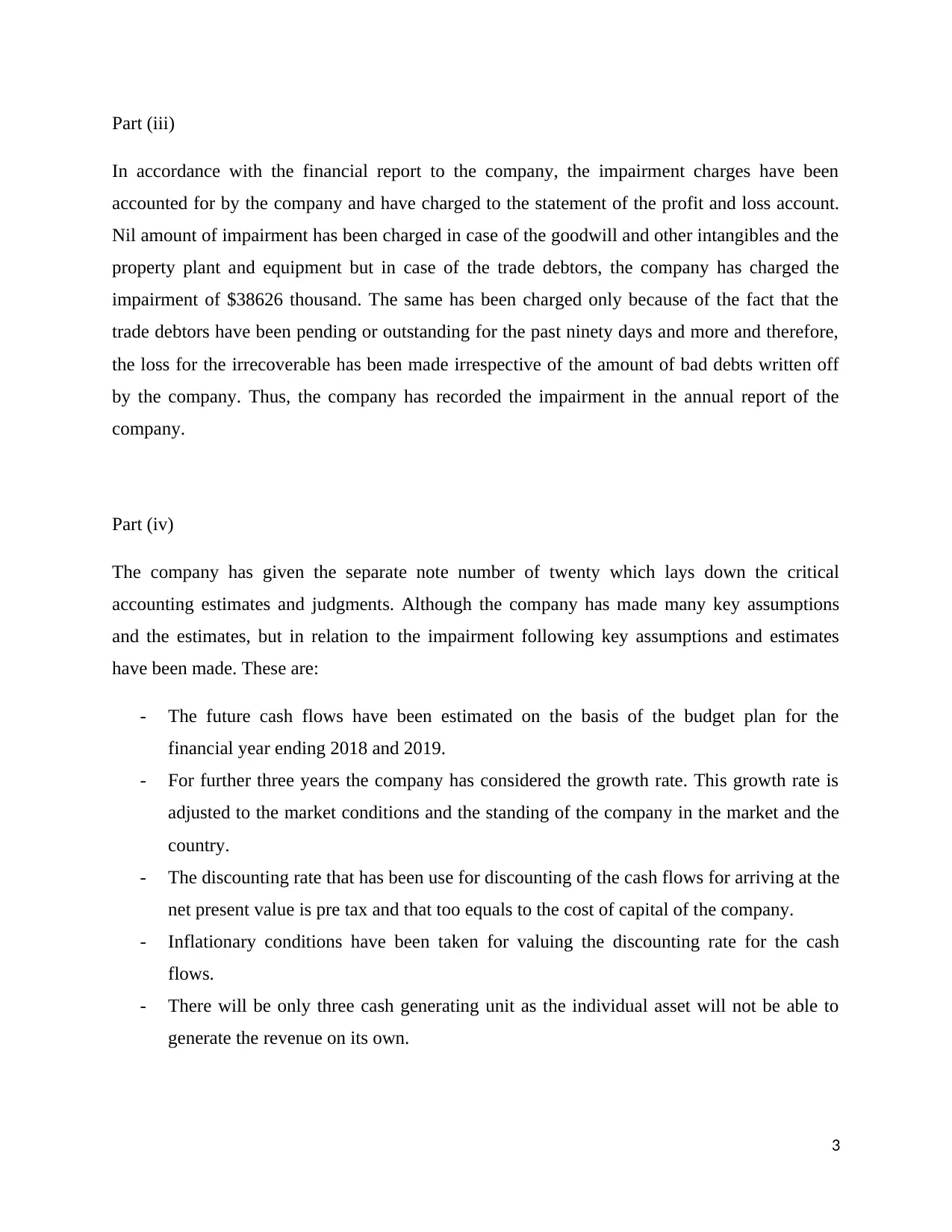
Part (iii)
In accordance with the financial report to the company, the impairment charges have been
accounted for by the company and have charged to the statement of the profit and loss account.
Nil amount of impairment has been charged in case of the goodwill and other intangibles and the
property plant and equipment but in case of the trade debtors, the company has charged the
impairment of $38626 thousand. The same has been charged only because of the fact that the
trade debtors have been pending or outstanding for the past ninety days and more and therefore,
the loss for the irrecoverable has been made irrespective of the amount of bad debts written off
by the company. Thus, the company has recorded the impairment in the annual report of the
company.
Part (iv)
The company has given the separate note number of twenty which lays down the critical
accounting estimates and judgments. Although the company has made many key assumptions
and the estimates, but in relation to the impairment following key assumptions and estimates
have been made. These are:
- The future cash flows have been estimated on the basis of the budget plan for the
financial year ending 2018 and 2019.
- For further three years the company has considered the growth rate. This growth rate is
adjusted to the market conditions and the standing of the company in the market and the
country.
- The discounting rate that has been use for discounting of the cash flows for arriving at the
net present value is pre tax and that too equals to the cost of capital of the company.
- Inflationary conditions have been taken for valuing the discounting rate for the cash
flows.
- There will be only three cash generating unit as the individual asset will not be able to
generate the revenue on its own.
3
In accordance with the financial report to the company, the impairment charges have been
accounted for by the company and have charged to the statement of the profit and loss account.
Nil amount of impairment has been charged in case of the goodwill and other intangibles and the
property plant and equipment but in case of the trade debtors, the company has charged the
impairment of $38626 thousand. The same has been charged only because of the fact that the
trade debtors have been pending or outstanding for the past ninety days and more and therefore,
the loss for the irrecoverable has been made irrespective of the amount of bad debts written off
by the company. Thus, the company has recorded the impairment in the annual report of the
company.
Part (iv)
The company has given the separate note number of twenty which lays down the critical
accounting estimates and judgments. Although the company has made many key assumptions
and the estimates, but in relation to the impairment following key assumptions and estimates
have been made. These are:
- The future cash flows have been estimated on the basis of the budget plan for the
financial year ending 2018 and 2019.
- For further three years the company has considered the growth rate. This growth rate is
adjusted to the market conditions and the standing of the company in the market and the
country.
- The discounting rate that has been use for discounting of the cash flows for arriving at the
net present value is pre tax and that too equals to the cost of capital of the company.
- Inflationary conditions have been taken for valuing the discounting rate for the cash
flows.
- There will be only three cash generating unit as the individual asset will not be able to
generate the revenue on its own.
3
⊘ This is a preview!⊘
Do you want full access?
Subscribe today to unlock all pages.

Trusted by 1+ million students worldwide
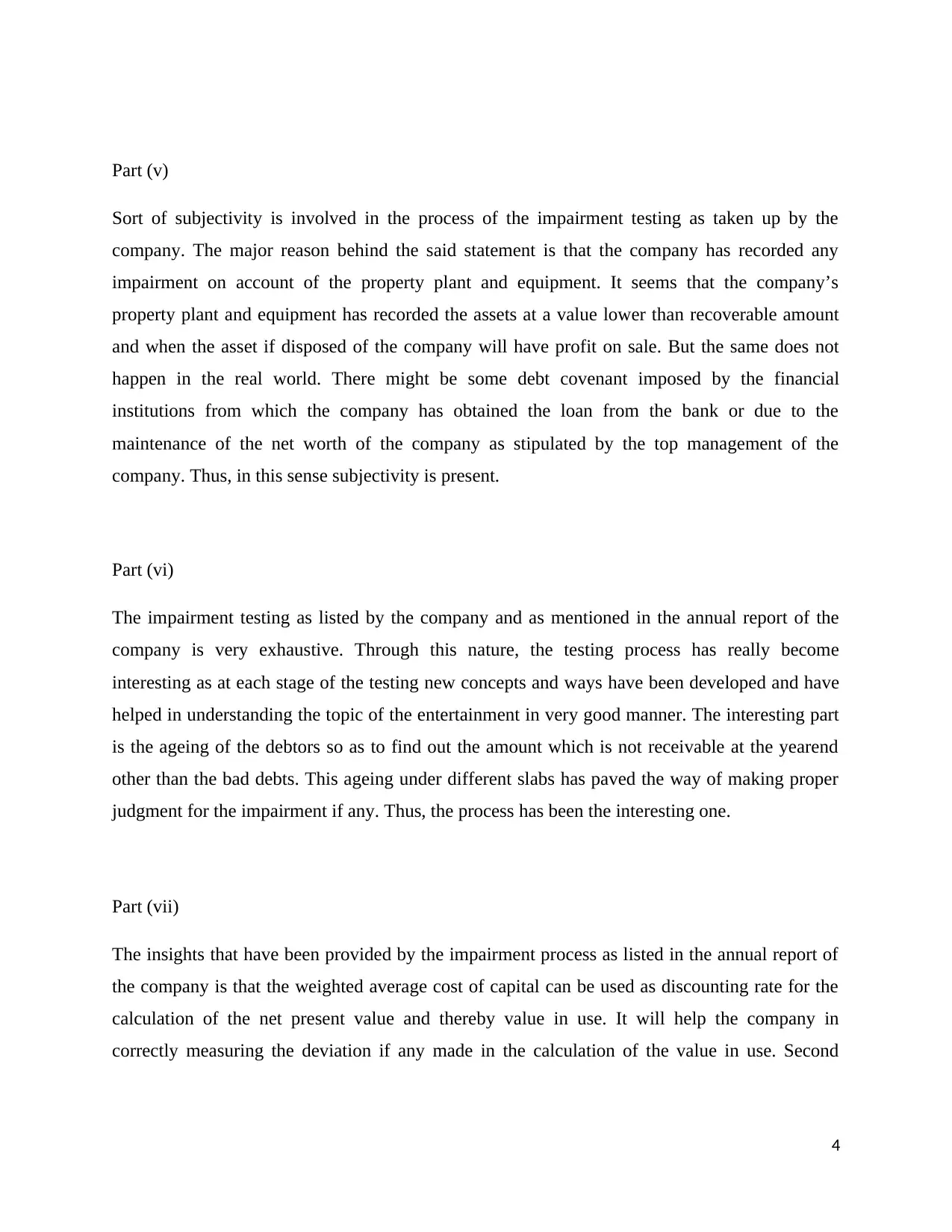
Part (v)
Sort of subjectivity is involved in the process of the impairment testing as taken up by the
company. The major reason behind the said statement is that the company has recorded any
impairment on account of the property plant and equipment. It seems that the company’s
property plant and equipment has recorded the assets at a value lower than recoverable amount
and when the asset if disposed of the company will have profit on sale. But the same does not
happen in the real world. There might be some debt covenant imposed by the financial
institutions from which the company has obtained the loan from the bank or due to the
maintenance of the net worth of the company as stipulated by the top management of the
company. Thus, in this sense subjectivity is present.
Part (vi)
The impairment testing as listed by the company and as mentioned in the annual report of the
company is very exhaustive. Through this nature, the testing process has really become
interesting as at each stage of the testing new concepts and ways have been developed and have
helped in understanding the topic of the entertainment in very good manner. The interesting part
is the ageing of the debtors so as to find out the amount which is not receivable at the yearend
other than the bad debts. This ageing under different slabs has paved the way of making proper
judgment for the impairment if any. Thus, the process has been the interesting one.
Part (vii)
The insights that have been provided by the impairment process as listed in the annual report of
the company is that the weighted average cost of capital can be used as discounting rate for the
calculation of the net present value and thereby value in use. It will help the company in
correctly measuring the deviation if any made in the calculation of the value in use. Second
4
Sort of subjectivity is involved in the process of the impairment testing as taken up by the
company. The major reason behind the said statement is that the company has recorded any
impairment on account of the property plant and equipment. It seems that the company’s
property plant and equipment has recorded the assets at a value lower than recoverable amount
and when the asset if disposed of the company will have profit on sale. But the same does not
happen in the real world. There might be some debt covenant imposed by the financial
institutions from which the company has obtained the loan from the bank or due to the
maintenance of the net worth of the company as stipulated by the top management of the
company. Thus, in this sense subjectivity is present.
Part (vi)
The impairment testing as listed by the company and as mentioned in the annual report of the
company is very exhaustive. Through this nature, the testing process has really become
interesting as at each stage of the testing new concepts and ways have been developed and have
helped in understanding the topic of the entertainment in very good manner. The interesting part
is the ageing of the debtors so as to find out the amount which is not receivable at the yearend
other than the bad debts. This ageing under different slabs has paved the way of making proper
judgment for the impairment if any. Thus, the process has been the interesting one.
Part (vii)
The insights that have been provided by the impairment process as listed in the annual report of
the company is that the weighted average cost of capital can be used as discounting rate for the
calculation of the net present value and thereby value in use. It will help the company in
correctly measuring the deviation if any made in the calculation of the value in use. Second
4
Paraphrase This Document
Need a fresh take? Get an instant paraphrase of this document with our AI Paraphraser
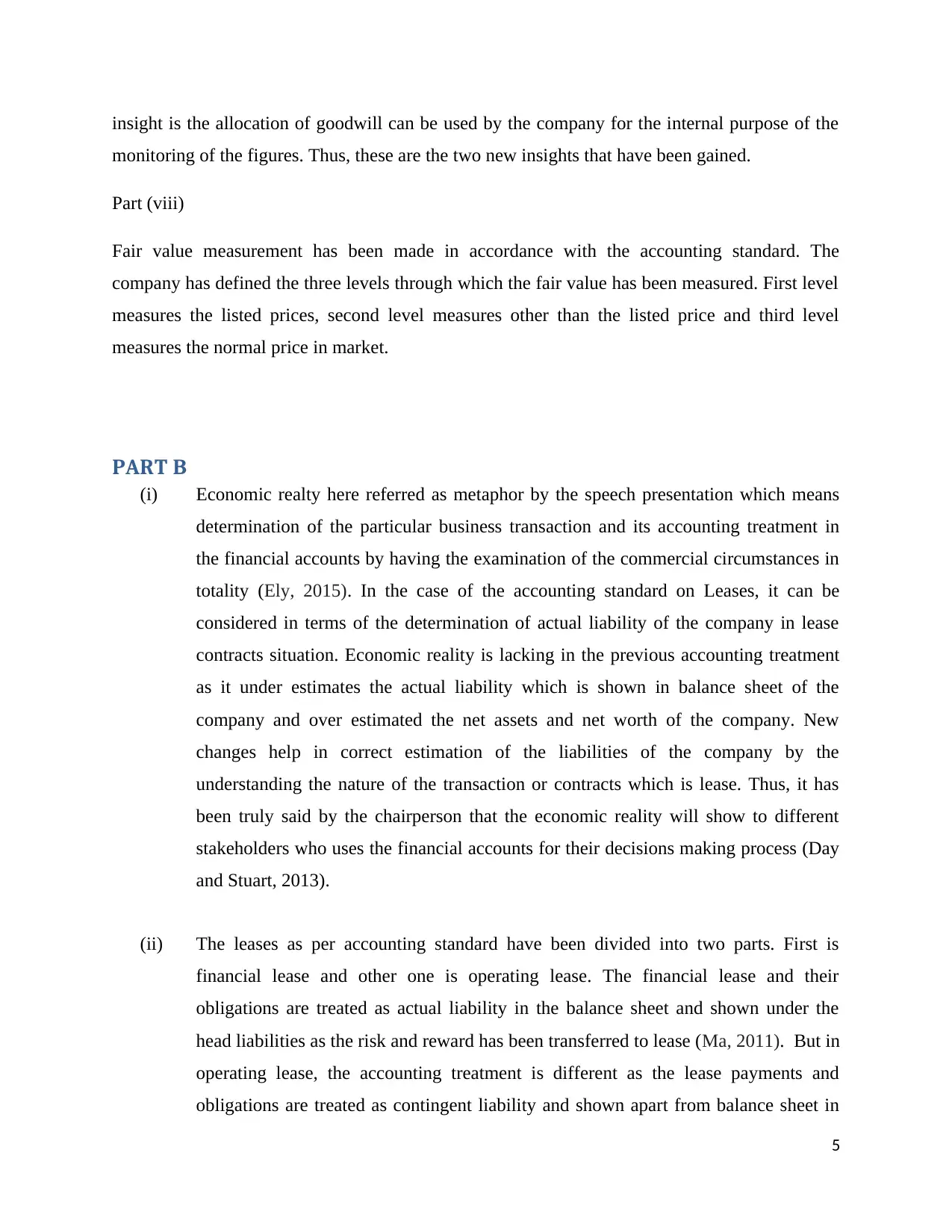
insight is the allocation of goodwill can be used by the company for the internal purpose of the
monitoring of the figures. Thus, these are the two new insights that have been gained.
Part (viii)
Fair value measurement has been made in accordance with the accounting standard. The
company has defined the three levels through which the fair value has been measured. First level
measures the listed prices, second level measures other than the listed price and third level
measures the normal price in market.
PART B
(i) Economic realty here referred as metaphor by the speech presentation which means
determination of the particular business transaction and its accounting treatment in
the financial accounts by having the examination of the commercial circumstances in
totality (Ely, 2015). In the case of the accounting standard on Leases, it can be
considered in terms of the determination of actual liability of the company in lease
contracts situation. Economic reality is lacking in the previous accounting treatment
as it under estimates the actual liability which is shown in balance sheet of the
company and over estimated the net assets and net worth of the company. New
changes help in correct estimation of the liabilities of the company by the
understanding the nature of the transaction or contracts which is lease. Thus, it has
been truly said by the chairperson that the economic reality will show to different
stakeholders who uses the financial accounts for their decisions making process (Day
and Stuart, 2013).
(ii) The leases as per accounting standard have been divided into two parts. First is
financial lease and other one is operating lease. The financial lease and their
obligations are treated as actual liability in the balance sheet and shown under the
head liabilities as the risk and reward has been transferred to lease (Ma, 2011). But in
operating lease, the accounting treatment is different as the lease payments and
obligations are treated as contingent liability and shown apart from balance sheet in
5
monitoring of the figures. Thus, these are the two new insights that have been gained.
Part (viii)
Fair value measurement has been made in accordance with the accounting standard. The
company has defined the three levels through which the fair value has been measured. First level
measures the listed prices, second level measures other than the listed price and third level
measures the normal price in market.
PART B
(i) Economic realty here referred as metaphor by the speech presentation which means
determination of the particular business transaction and its accounting treatment in
the financial accounts by having the examination of the commercial circumstances in
totality (Ely, 2015). In the case of the accounting standard on Leases, it can be
considered in terms of the determination of actual liability of the company in lease
contracts situation. Economic reality is lacking in the previous accounting treatment
as it under estimates the actual liability which is shown in balance sheet of the
company and over estimated the net assets and net worth of the company. New
changes help in correct estimation of the liabilities of the company by the
understanding the nature of the transaction or contracts which is lease. Thus, it has
been truly said by the chairperson that the economic reality will show to different
stakeholders who uses the financial accounts for their decisions making process (Day
and Stuart, 2013).
(ii) The leases as per accounting standard have been divided into two parts. First is
financial lease and other one is operating lease. The financial lease and their
obligations are treated as actual liability in the balance sheet and shown under the
head liabilities as the risk and reward has been transferred to lease (Ma, 2011). But in
operating lease, the accounting treatment is different as the lease payments and
obligations are treated as contingent liability and shown apart from balance sheet in
5
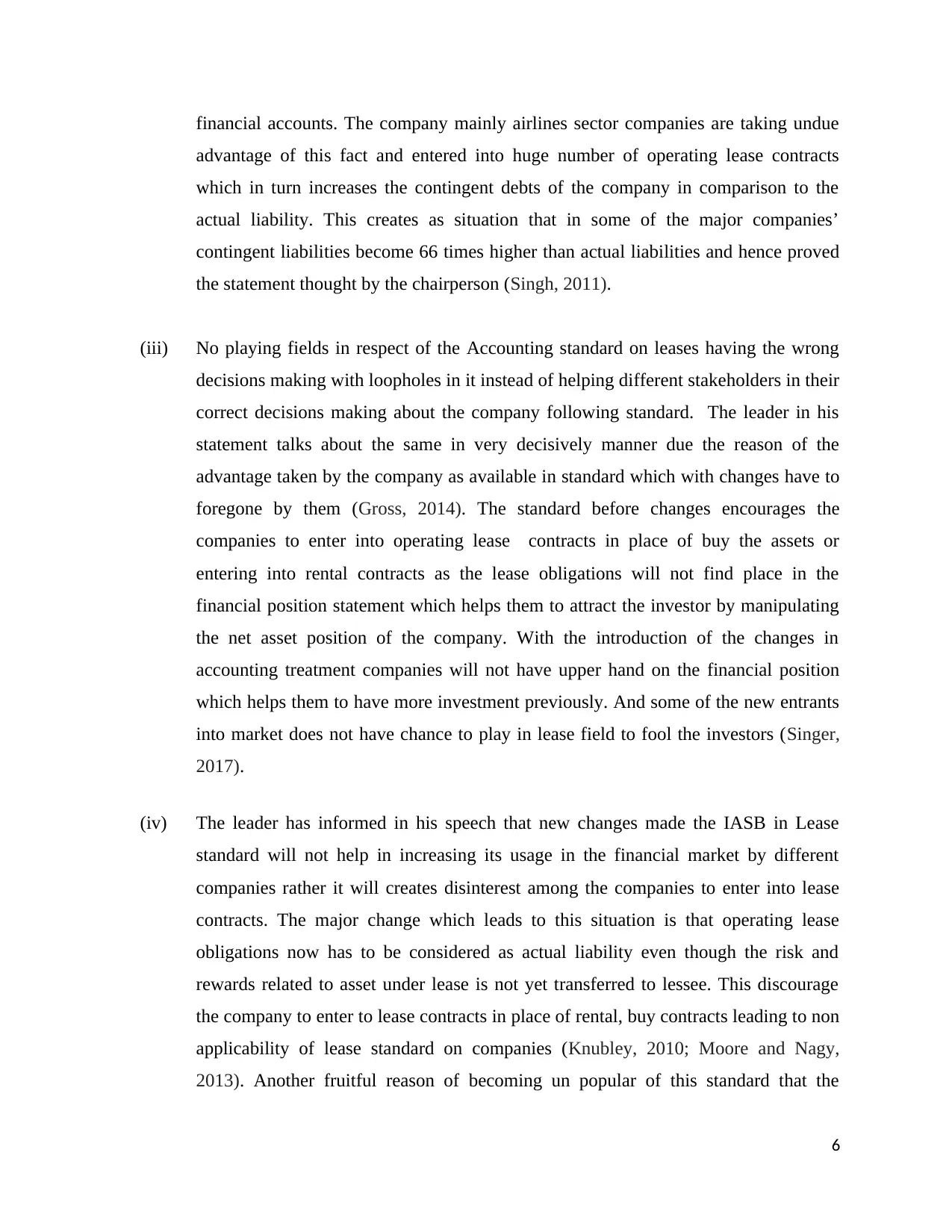
financial accounts. The company mainly airlines sector companies are taking undue
advantage of this fact and entered into huge number of operating lease contracts
which in turn increases the contingent debts of the company in comparison to the
actual liability. This creates as situation that in some of the major companies’
contingent liabilities become 66 times higher than actual liabilities and hence proved
the statement thought by the chairperson (Singh, 2011).
(iii) No playing fields in respect of the Accounting standard on leases having the wrong
decisions making with loopholes in it instead of helping different stakeholders in their
correct decisions making about the company following standard. The leader in his
statement talks about the same in very decisively manner due the reason of the
advantage taken by the company as available in standard which with changes have to
foregone by them (Gross, 2014). The standard before changes encourages the
companies to enter into operating lease contracts in place of buy the assets or
entering into rental contracts as the lease obligations will not find place in the
financial position statement which helps them to attract the investor by manipulating
the net asset position of the company. With the introduction of the changes in
accounting treatment companies will not have upper hand on the financial position
which helps them to have more investment previously. And some of the new entrants
into market does not have chance to play in lease field to fool the investors (Singer,
2017).
(iv) The leader has informed in his speech that new changes made the IASB in Lease
standard will not help in increasing its usage in the financial market by different
companies rather it will creates disinterest among the companies to enter into lease
contracts. The major change which leads to this situation is that operating lease
obligations now has to be considered as actual liability even though the risk and
rewards related to asset under lease is not yet transferred to lessee. This discourage
the company to enter to lease contracts in place of rental, buy contracts leading to non
applicability of lease standard on companies (Knubley, 2010; Moore and Nagy,
2013). Another fruitful reason of becoming un popular of this standard that the
6
advantage of this fact and entered into huge number of operating lease contracts
which in turn increases the contingent debts of the company in comparison to the
actual liability. This creates as situation that in some of the major companies’
contingent liabilities become 66 times higher than actual liabilities and hence proved
the statement thought by the chairperson (Singh, 2011).
(iii) No playing fields in respect of the Accounting standard on leases having the wrong
decisions making with loopholes in it instead of helping different stakeholders in their
correct decisions making about the company following standard. The leader in his
statement talks about the same in very decisively manner due the reason of the
advantage taken by the company as available in standard which with changes have to
foregone by them (Gross, 2014). The standard before changes encourages the
companies to enter into operating lease contracts in place of buy the assets or
entering into rental contracts as the lease obligations will not find place in the
financial position statement which helps them to attract the investor by manipulating
the net asset position of the company. With the introduction of the changes in
accounting treatment companies will not have upper hand on the financial position
which helps them to have more investment previously. And some of the new entrants
into market does not have chance to play in lease field to fool the investors (Singer,
2017).
(iv) The leader has informed in his speech that new changes made the IASB in Lease
standard will not help in increasing its usage in the financial market by different
companies rather it will creates disinterest among the companies to enter into lease
contracts. The major change which leads to this situation is that operating lease
obligations now has to be considered as actual liability even though the risk and
rewards related to asset under lease is not yet transferred to lessee. This discourage
the company to enter to lease contracts in place of rental, buy contracts leading to non
applicability of lease standard on companies (Knubley, 2010; Moore and Nagy,
2013). Another fruitful reason of becoming un popular of this standard that the
6
⊘ This is a preview!⊘
Do you want full access?
Subscribe today to unlock all pages.

Trusted by 1+ million students worldwide
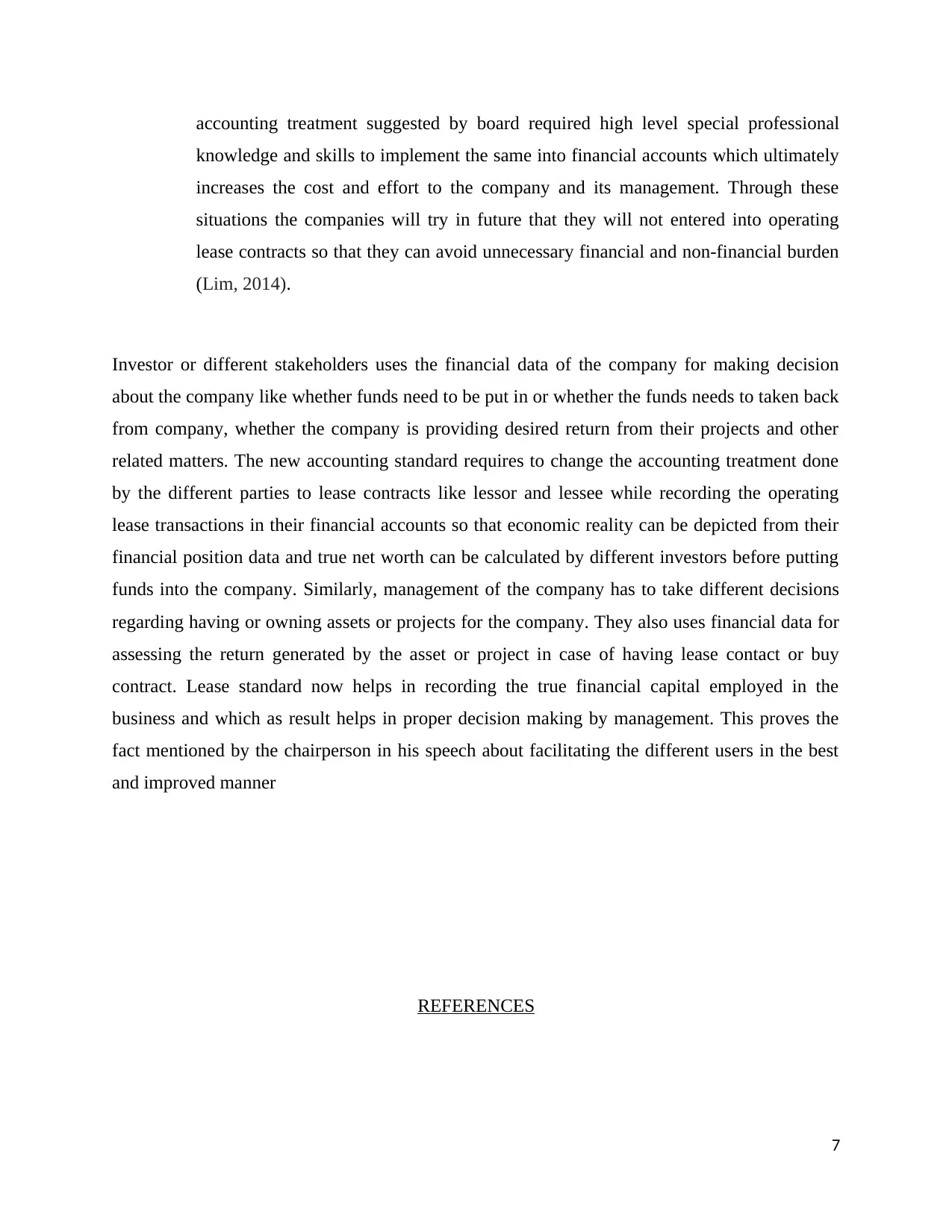
accounting treatment suggested by board required high level special professional
knowledge and skills to implement the same into financial accounts which ultimately
increases the cost and effort to the company and its management. Through these
situations the companies will try in future that they will not entered into operating
lease contracts so that they can avoid unnecessary financial and non-financial burden
(Lim, 2014).
Investor or different stakeholders uses the financial data of the company for making decision
about the company like whether funds need to be put in or whether the funds needs to taken back
from company, whether the company is providing desired return from their projects and other
related matters. The new accounting standard requires to change the accounting treatment done
by the different parties to lease contracts like lessor and lessee while recording the operating
lease transactions in their financial accounts so that economic reality can be depicted from their
financial position data and true net worth can be calculated by different investors before putting
funds into the company. Similarly, management of the company has to take different decisions
regarding having or owning assets or projects for the company. They also uses financial data for
assessing the return generated by the asset or project in case of having lease contact or buy
contract. Lease standard now helps in recording the true financial capital employed in the
business and which as result helps in proper decision making by management. This proves the
fact mentioned by the chairperson in his speech about facilitating the different users in the best
and improved manner
REFERENCES
7
knowledge and skills to implement the same into financial accounts which ultimately
increases the cost and effort to the company and its management. Through these
situations the companies will try in future that they will not entered into operating
lease contracts so that they can avoid unnecessary financial and non-financial burden
(Lim, 2014).
Investor or different stakeholders uses the financial data of the company for making decision
about the company like whether funds need to be put in or whether the funds needs to taken back
from company, whether the company is providing desired return from their projects and other
related matters. The new accounting standard requires to change the accounting treatment done
by the different parties to lease contracts like lessor and lessee while recording the operating
lease transactions in their financial accounts so that economic reality can be depicted from their
financial position data and true net worth can be calculated by different investors before putting
funds into the company. Similarly, management of the company has to take different decisions
regarding having or owning assets or projects for the company. They also uses financial data for
assessing the return generated by the asset or project in case of having lease contact or buy
contract. Lease standard now helps in recording the true financial capital employed in the
business and which as result helps in proper decision making by management. This proves the
fact mentioned by the chairperson in his speech about facilitating the different users in the best
and improved manner
REFERENCES
7
Paraphrase This Document
Need a fresh take? Get an instant paraphrase of this document with our AI Paraphraser
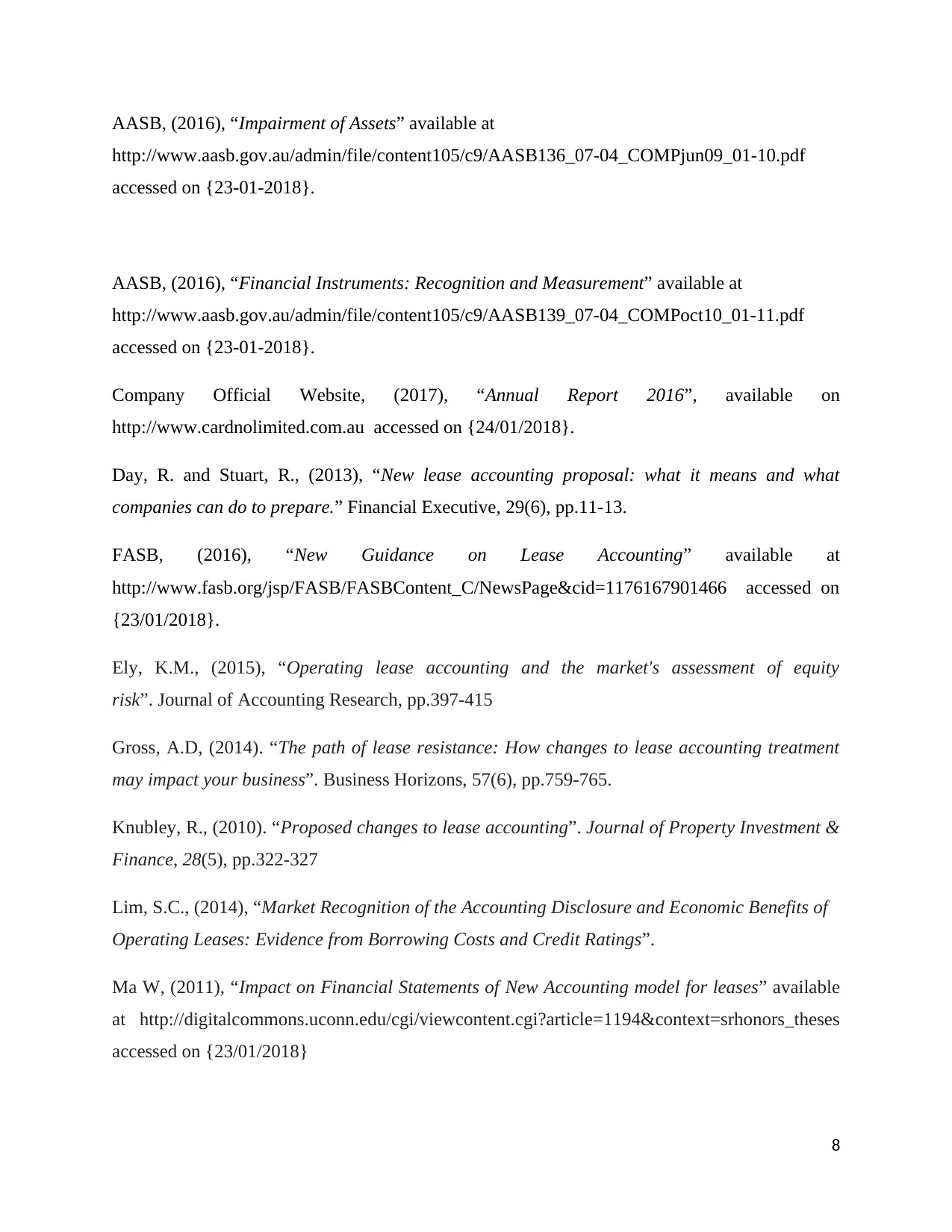
AASB, (2016), “Impairment of Assets” available at
http://www.aasb.gov.au/admin/file/content105/c9/AASB136_07-04_COMPjun09_01-10.pdf
accessed on {23-01-2018}.
AASB, (2016), “Financial Instruments: Recognition and Measurement” available at
http://www.aasb.gov.au/admin/file/content105/c9/AASB139_07-04_COMPoct10_01-11.pdf
accessed on {23-01-2018}.
Company Official Website, (2017), “Annual Report 2016”, available on
http://www.cardnolimited.com.au accessed on {24/01/2018}.
Day, R. and Stuart, R., (2013), “New lease accounting proposal: what it means and what
companies can do to prepare.” Financial Executive, 29(6), pp.11-13.
FASB, (2016), “New Guidance on Lease Accounting” available at
http://www.fasb.org/jsp/FASB/FASBContent_C/NewsPage&cid=1176167901466 accessed on
{23/01/2018}.
Ely, K.M., (2015), “Operating lease accounting and the market's assessment of equity
risk”. Journal of Accounting Research, pp.397-415
Gross, A.D, (2014). “The path of lease resistance: How changes to lease accounting treatment
may impact your business”. Business Horizons, 57(6), pp.759-765.
Knubley, R., (2010). “Proposed changes to lease accounting”. Journal of Property Investment &
Finance, 28(5), pp.322-327
Lim, S.C., (2014), “Market Recognition of the Accounting Disclosure and Economic Benefits of
Operating Leases: Evidence from Borrowing Costs and Credit Ratings”.
Ma W, (2011), “Impact on Financial Statements of New Accounting model for leases” available
at http://digitalcommons.uconn.edu/cgi/viewcontent.cgi?article=1194&context=srhonors_theses
accessed on {23/01/2018}
8
http://www.aasb.gov.au/admin/file/content105/c9/AASB136_07-04_COMPjun09_01-10.pdf
accessed on {23-01-2018}.
AASB, (2016), “Financial Instruments: Recognition and Measurement” available at
http://www.aasb.gov.au/admin/file/content105/c9/AASB139_07-04_COMPoct10_01-11.pdf
accessed on {23-01-2018}.
Company Official Website, (2017), “Annual Report 2016”, available on
http://www.cardnolimited.com.au accessed on {24/01/2018}.
Day, R. and Stuart, R., (2013), “New lease accounting proposal: what it means and what
companies can do to prepare.” Financial Executive, 29(6), pp.11-13.
FASB, (2016), “New Guidance on Lease Accounting” available at
http://www.fasb.org/jsp/FASB/FASBContent_C/NewsPage&cid=1176167901466 accessed on
{23/01/2018}.
Ely, K.M., (2015), “Operating lease accounting and the market's assessment of equity
risk”. Journal of Accounting Research, pp.397-415
Gross, A.D, (2014). “The path of lease resistance: How changes to lease accounting treatment
may impact your business”. Business Horizons, 57(6), pp.759-765.
Knubley, R., (2010). “Proposed changes to lease accounting”. Journal of Property Investment &
Finance, 28(5), pp.322-327
Lim, S.C., (2014), “Market Recognition of the Accounting Disclosure and Economic Benefits of
Operating Leases: Evidence from Borrowing Costs and Credit Ratings”.
Ma W, (2011), “Impact on Financial Statements of New Accounting model for leases” available
at http://digitalcommons.uconn.edu/cgi/viewcontent.cgi?article=1194&context=srhonors_theses
accessed on {23/01/2018}
8
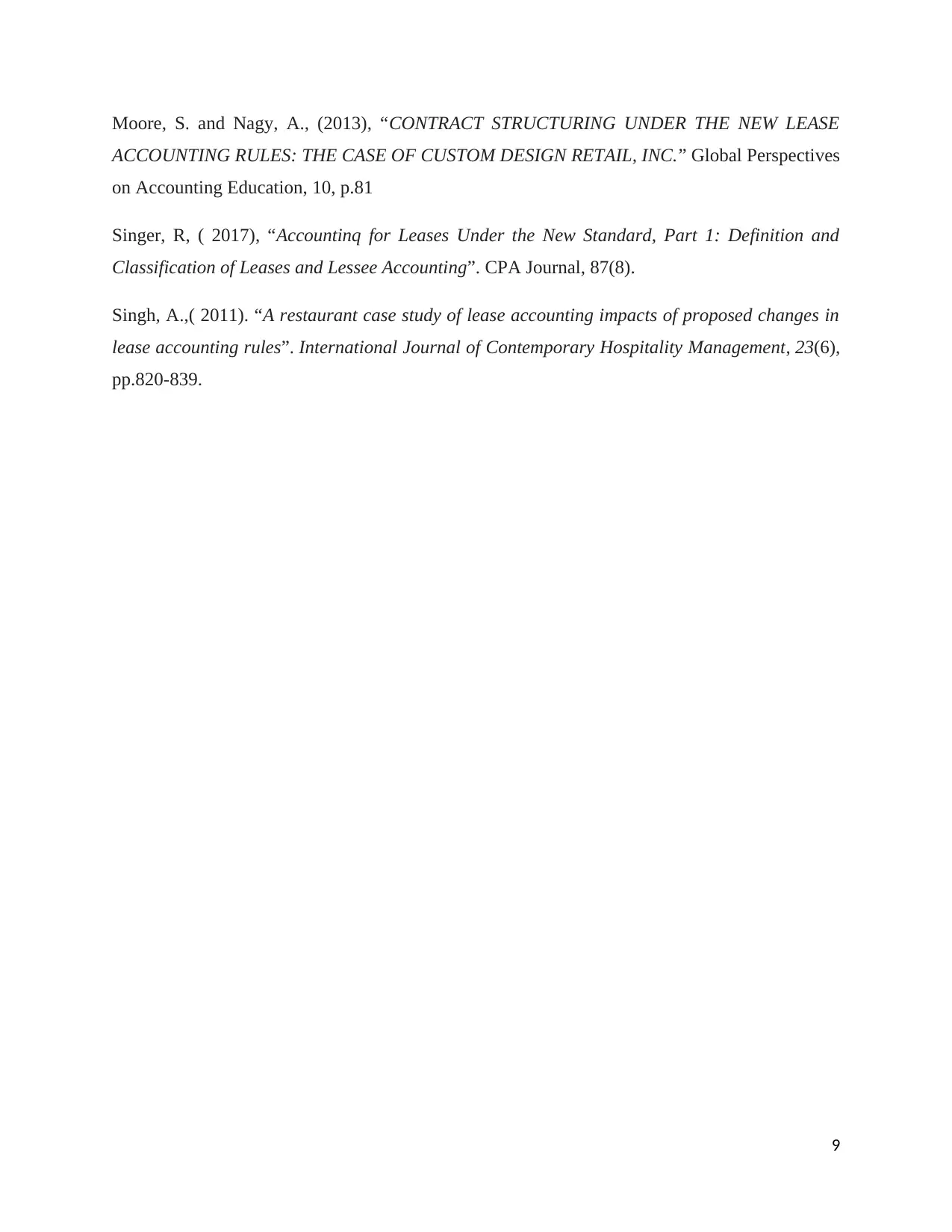
Moore, S. and Nagy, A., (2013), “CONTRACT STRUCTURING UNDER THE NEW LEASE
ACCOUNTING RULES: THE CASE OF CUSTOM DESIGN RETAIL, INC.” Global Perspectives
on Accounting Education, 10, p.81
Singer, R, ( 2017), “Accountinq for Leases Under the New Standard, Part 1: Definition and
Classification of Leases and Lessee Accounting”. CPA Journal, 87(8).
Singh, A.,( 2011). “A restaurant case study of lease accounting impacts of proposed changes in
lease accounting rules”. International Journal of Contemporary Hospitality Management, 23(6),
pp.820-839.
9
ACCOUNTING RULES: THE CASE OF CUSTOM DESIGN RETAIL, INC.” Global Perspectives
on Accounting Education, 10, p.81
Singer, R, ( 2017), “Accountinq for Leases Under the New Standard, Part 1: Definition and
Classification of Leases and Lessee Accounting”. CPA Journal, 87(8).
Singh, A.,( 2011). “A restaurant case study of lease accounting impacts of proposed changes in
lease accounting rules”. International Journal of Contemporary Hospitality Management, 23(6),
pp.820-839.
9
⊘ This is a preview!⊘
Do you want full access?
Subscribe today to unlock all pages.

Trusted by 1+ million students worldwide
1 out of 9
Related Documents
Your All-in-One AI-Powered Toolkit for Academic Success.
+13062052269
info@desklib.com
Available 24*7 on WhatsApp / Email
![[object Object]](/_next/static/media/star-bottom.7253800d.svg)
Unlock your academic potential
Copyright © 2020–2025 A2Z Services. All Rights Reserved. Developed and managed by ZUCOL.





